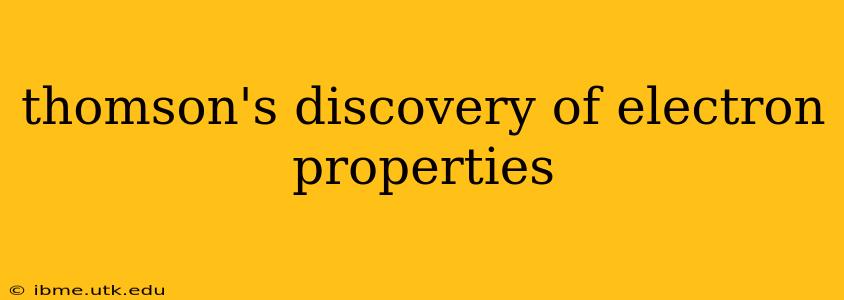J.J. Thomson's groundbreaking experiments with cathode rays at the end of the 19th century revolutionized our understanding of the atom. His work not only confirmed the existence of electrons, subatomic particles carrying a negative charge, but also allowed him to determine crucial properties of these fundamental building blocks of matter. This article delves into Thomson's experiments, their significance, and the lasting impact on the field of physics.
What were Thomson's cathode ray experiments?
Thomson's experiments centered around the study of cathode rays, streams of particles emitted from the cathode (negative electrode) in a vacuum tube when a high voltage is applied. He meticulously designed and conducted a series of experiments to investigate the nature of these rays, systematically ruling out alternative hypotheses. His experimental setup involved a partially evacuated glass tube with electrodes at each end. Applying a high voltage produced a beam of cathode rays visible as a glowing green light where it struck the glass. Key to his discovery was his ability to manipulate and measure the behavior of these rays under various conditions.
How did Thomson measure the charge-to-mass ratio of the electron?
One of Thomson's most significant achievements was determining the charge-to-mass ratio (e/m) of the cathode ray particles. By applying electric and magnetic fields to the cathode ray beam, he could deflect its path. By carefully balancing the electric and magnetic forces, he was able to measure the deflection and calculate the e/m ratio. The remarkable result was that the e/m ratio was much larger than that of any known ion, implying either a very small mass or a very large charge, or a combination of both. This was a strong indication that the cathode rays were composed of particles much lighter than atoms, subsequently identified as electrons.
What was the significance of Thomson's discovery of the electron?
Thomson's work was revolutionary for several reasons. Firstly, it demonstrated the existence of subatomic particles, shattering the then-prevailing view of the atom as an indivisible, fundamental unit of matter. This discovery opened up a new era in physics, leading to the development of new models of the atom and our understanding of atomic structure. Secondly, the determination of the e/m ratio provided a crucial piece of information about the electron, allowing scientists to begin to quantify its properties. This paved the way for future experiments aimed at determining the charge and mass of the electron separately.
How did Thomson's model of the atom differ from earlier models?
Prior to Thomson's discovery, the prevailing model of the atom was a solid, indivisible sphere. Thomson proposed the "plum pudding" model, which depicted the atom as a positively charged sphere with negatively charged electrons embedded within it like plums in a pudding. This model, while ultimately superseded by later models like Rutherford's nuclear model, was a significant step forward in understanding atomic structure.
What experiments followed Thomson's work that further characterized the electron?
Following Thomson's groundbreaking work, many scientists built upon his findings. Robert Millikan's oil drop experiment, for instance, successfully determined the charge of the electron, a feat that, combined with Thomson's e/m ratio, allowed for the calculation of the electron's mass. These subsequent experiments further refined our understanding of the electron's properties, solidifying its place as a fundamental particle.
What is the modern understanding of electron properties?
Today, we understand the electron as a fundamental particle with a negative charge (-1.602 x 10^-19 Coulombs), a negligible mass (9.109 x 10^-31 kg), and wave-particle duality, meaning it exhibits properties of both waves and particles. Thomson's initial work laid the essential foundation for this understanding. His legacy extends far beyond his specific findings; he established a new experimental approach and a paradigm shift in our understanding of the universe at its most fundamental level.
The discovery of the electron's properties marked a watershed moment in physics. Thomson's meticulous experiments and innovative thinking fundamentally altered our understanding of matter, inspiring further research that continues to shape our knowledge of the universe today.
